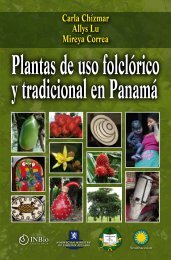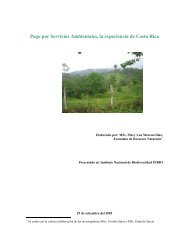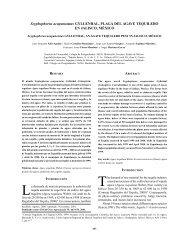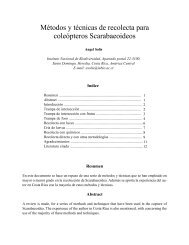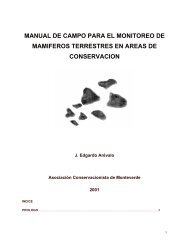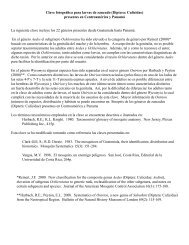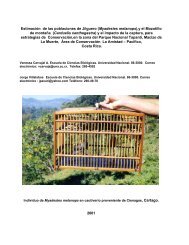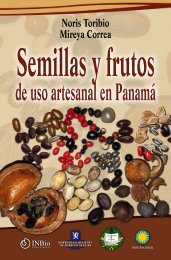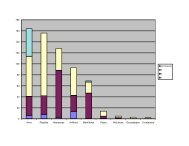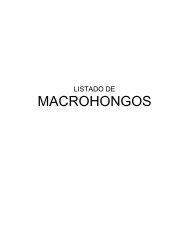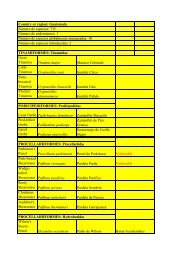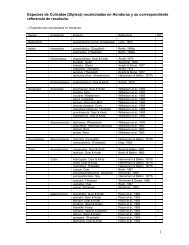the genus Coccocarpia (Peltigerales: Coccocarpiaceae) - Instituto ...
the genus Coccocarpia (Peltigerales: Coccocarpiaceae) - Instituto ...
the genus Coccocarpia (Peltigerales: Coccocarpiaceae) - Instituto ...
You also want an ePaper? Increase the reach of your titles
YUMPU automatically turns print PDFs into web optimized ePapers that Google loves.
Selected specimens examined: COSTA RICA. Alajuela: Volcán Tenorio National Park, Mar 2004, Nelsen<br />
3762 (INB-4031349, WIS), Sipman 51769 (B, INB-4031350), 51831 (B, INB-4031351), Trest 1553c (CR,<br />
INB-4031352). Guanacaste: Volcán Tenorio National Park, Mar 2004, Aptroot 60647 (ABL, INB-3968061).<br />
Heredia: La Selva Protection Zone, Oct 2002, Lücking 16002f (F). Puntarenas: La Amistad International<br />
Park, Jul 2002, Lücking 15260f (INB-3976254), Nelsen 2116a (WIS), Sipman 48020g (INB-3927549). Las<br />
Cruces Biological Station, Oct 2004, Sipman 53372 (B, INB-3993874).<br />
<strong>Coccocarpia</strong> tenuissima Müll. Arg. Fig. 3G<br />
Notes: Found only once but <strong>the</strong> material agrees well with <strong>the</strong> type (Fig. 3G).<br />
Selected specimens examined: COSTA RICA. Alajuela: Volcán Tenorio National Park, Mar 2004,<br />
Aptroot 60525 (ABL, INB-3967677).<br />
Ecological analysis<br />
<strong>Coccocarpia</strong> erythroxyli and C. palmicola are not only <strong>the</strong> most abundant species but also<br />
show <strong>the</strong> widest ecological amplitude, ranging from (semi-)arid to perhumid climates and<br />
from sea level to <strong>the</strong> subparamo zone at 3500 m (Fig. 6). This coincides with <strong>the</strong> statements<br />
by ARVIDSSON (1983) that <strong>the</strong>se two species are <strong>the</strong> only ones also found in extratropical<br />
regions and <strong>the</strong> only ones that reach altitudes above 4000 m in <strong>the</strong> Andes. We could not<br />
confirm <strong>the</strong> observation of ARVIDSSON (1983) that <strong>the</strong> two forms of <strong>Coccocarpia</strong> with<br />
adnate thallus and blue-black rhizines versus loosely attached thallus and white rhizines<br />
intergrade along an altitudinal gradient; <strong>the</strong> typical 'montane' form was also found in <strong>the</strong><br />
lowland rain forest at 50 m altitude.<br />
According to ARVIDSSON (1983), <strong>Coccocarpia</strong> pellita is ano<strong>the</strong>r common and<br />
widespread taxon at a world-wide level, but at <strong>the</strong> regional level in our material was<br />
restricted to (per-)humid climates between 1000 and 3500 m. On <strong>the</strong> contrary, C. dissecta<br />
seems to be a lowland species with a range from (semi-)arid to (sub-)humid climates. The<br />
collections of C. guimarana also originate from lowland subhumid forest. Three o<strong>the</strong>r<br />
species apparently confined to lower altitudes are C. glaucina, C. neglecta, and C.<br />
tenuissima (Fig. 6).<br />
Ano<strong>the</strong>r group of species, being mostly found at mid elevations in (sub-)humid to<br />
perhumid climates, includes C. adnata, C. epiphylla, C. aff. imbricascens, C.<br />
microphyllina, and C. stellata (Fig. 6). <strong>Coccocarpia</strong> gallaicoi possibly also belongs here,<br />
but <strong>the</strong> label data on <strong>the</strong> type material are insufficient to draw meaningful ecological<br />
conclusions.<br />
The three remaining taxa, <strong>Coccocarpia</strong> domingensis, C. filiformis, and C. prostrata, are<br />
mostly confined to humid climates but show a wide altitudinal range, from <strong>the</strong> lowland and<br />
<strong>the</strong> colline to <strong>the</strong> upper montane and subparamo zone (Fig. 6).<br />
454





